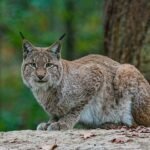When a small tabby cat wandered into a zoo lynx enclosure in Russia years ago, staff expected the worst. Instead, they witnessed the beginning of one of the most remarkable interspecies friendships ever documented in a captive setting.
This isn’t just a cute animal story—it’s a case study that has intrigued animal behaviorists and challenged our understanding of feline social structures.
A Chance Encounter Becomes Family
Image by unsplash
The story began with a hungry stray cat later named Dusya. Searching for food and shelter, she somehow found her way into the habitat of Linda, a female Eurasian lynx. Under normal circumstances, this encounter should have ended badly for the smaller feline. After all, lynx are powerful predators that regularly hunt animals Dusya’s size in the wild.
Yet something extraordinary happened instead. The zoo animals formed an immediate connection. Zookeepers observed Linda’s body language shift from predatory alertness to curiosity and then to what can only be described as acceptance.
“We prepared to intervene,” explained head zookeeper Dmitri Vasiliev. “But it quickly became clear this wasn’t a predator-prey situation. Linda’s posture was relaxed, her ears forward—all signs of positive interest rather than hunting behavior.”
Beyond Initial Curiosity
Image by unsplash
What might have been a fleeting moment of unusual tolerance evolved into something much deeper. Within days, staff documented Linda and Dusya sleeping side by side. Soon after, they began grooming each other—a significant behavior that indicates trust and social bonding among felines.
“Mutual grooming is incredibly meaningful in feline social structures,” notes feline behaviorist Dr. Elena Fedorova. “It’s not just about hygiene but about establishing and maintaining social bonds. When we observed this between species with such different sizes and backgrounds, it challenged many of our assumptions about hardwired behaviors.”
Perhaps most surprising was their shared mealtime ritual. Linda, who normally guarded her food aggressively, allowed Dusya to eat alongside her. This unusual behavior suggests a relationship that transcended normal feline territorial instincts.
The Science Behind the Friendship
What makes this type of interspecies adoption possible? Researchers point to several factors:
First, Linda had been hand-raised at the zoo after being orphaned as a cub. This early human contact may have altered her typical species-specific behaviors. Additionally, she had never successfully raised cubs of her own, potentially leaving her with unfulfilled maternal instincts.
For Dusya’s part, her early life as a stray likely made her adaptable and less fearful than typical house cats. Her need for survival may have overridden natural caution around larger predators.
“We see a phenomenon called ‘adaptive behavioral flexibility’ in many species,” explains Dr. Fedorova. “Animals can modify instinctual behaviors when environmental conditions change. In captivity, where food is plentiful and survival pressures are removed, these unusual relationships become possible.”
A Legacy of Love and Loss
Image by unsplash
For twelve remarkable years, Dusya and Linda remained inseparable companions. Their relationship became a highlight for zoo visitors and a valuable case study for researchers interested in animal behavior.
When Dusya passed away recently at age 12, the loss affected not only the zoo staff who had watched this unusual relationship flourish but also Linda herself. Keepers reported changes in the lynx’s behavior—decreased activity, reduced appetite, and more time spent in areas she had shared with her smaller companion.
“We’re monitoring Linda closely,” Vasiliev shares. “Animals experience grief differently than humans, but strong social bonds do exist across many species, and their disruption can cause measurable distress.”




